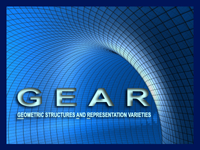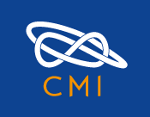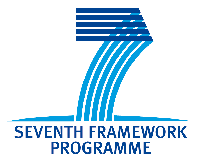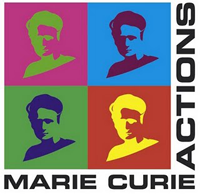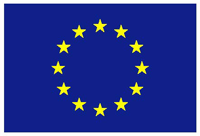Schedule
| |
Monday, 12 |
Tuesday, 13 |
Wednesday, 14 |
Thursday, 15 |
Friday, 16 |
| 10:00-11:00 |
|
B.Collier |
R. Mazzeo |
P. Boalch |
J. Hurtubise |
| 11:00-11:30 |
Coffee |
Coffee |
Coffee |
Coffee |
| 11:30-12:30 |
P. Gothen |
S. Gukov |
I. Mundet |
D. Baraglia |
| 12:30--13:30 |
Lunch |
Lunch |
Lunch |
O. Biquard |
| 13:45-14:30 |
Registration & lunch |
End of conference |
| 14:30-15:30 |
T. Hausel |
M. Gualtieri |
L. Schaposnik |
X. de la Ossa |
|
| 15:30-16:00 |
Coffee |
Coffee |
Coffee |
Coffee |
| 16:00-17:00 |
A. Wienhard |
G. Cavalcanti |
B. Pym |
M. Garcia-Fernandez |
| 17:00-18:30 |
Reception & coffee |
|
| 20:30 |
|
Social Dinner starts at 20:30 |
Programme
David Baraglia (Adelaide):
Integrability of moduli stacks of parahoric Higgs bundles
Expand Abstract
The moduli stack of G-Higgs bundles on a curve is the cotangent bundle of the stack of principal G-bundles. Hitchin showed that applying invariant polynomials to the Higgs field gives an
integrable system. Motivated by the Langlands program we consider the following generalisation: take the cotangent bundle of the stack of torsors over a non-constant group scheme. Do we still get
an integrable system? We conjecture and in many cases prove that this is the case for so-called parahoric group schemes. A special case of this includes strongly parabolic Higgs bundles. There is
also an interpretation in terms of equivariant Higgs bundles. This is joint work with Masoud Kamgarpour and Rohith Varma.
Olivier Biquard (École Normale Supérieure, Paris):
SL(∞,ℝ), Higgs bundles, and quantization
Expand Abstract
I shall explain how a Hitchin-Teichmüller component for SL(∞,ℝ) can be parametrized by holomorphic differentials, and I shall discuss properties of the corresponding Hitchin's map.
Philip Boalch (Orsay):
Wild character varieties, meromorphic Hitchin systems and Dynkin diagrams
Expand Abstract
Lecture Slides
In 1987 Hitchin discovered a new family of algebraic integrable systems, solvable by spectral curve methods. One novelty was that the base curve was of arbitrary genus. Later on it was
understood how to extend Hitchin's viewpoint, allowing poles in the Higgs fields, and thus incorporating many of the known classical integrable systems, which occur as meromorphic Hitchin systems
when the base curve has genus zero. However, in a different 1987 paper, Hitchin also proved that the total space of his integrable system admits a hyperkahler metric and (combined with work of
Donaldson, Corlette and Simpson) this shows that the differentiable manifold underlying the total space of the integrable system has a simple description as a character variety
Hom(π1(Σ),G)/G
of representations of the fundamental group of the base curve Σ into the structure group G. This misses the main cases of interest classically, but it turns out there is an extension. In work
with Biquard from 2004 Hitchin's hyperkahler story was extended to the meromorphic case, upgrading the speakers holomorphic symplectic quotient approach from 1999. Using the irregular
Riemann--Hilbert correspondence the total space of such integrable systems then has a simple explicit description in terms of monodromy and Stokes data, generalising the character varieties. The
construction of such “wild character varieties”, as algebraic symplectic varieties, was recently completed in work with D. Yamakawa. The main aim of this talk is to describe some simple examples
of wild character varieties including some cases of complex dimension 2, familiar in the theory of Painleve equations, although their structure as new examples of complete hyperkahler manifolds
(gravitational instantons) is perhaps less well-known. The language of quasi-Hamiltonian geometry will be used and we will see how this leads to relations to quivers, Catalan numbers and
triangulations, and in particular how simple examples of gluing wild boundary conditions for Stokes data leads to duplicial algebras in the sense of Loday.
Gil Cavalcanti (Utrecht):
Stable Generalized Complex Structures
Expand Abstract
Stable generalized complex structures are a class of structures that are not too far from being symplectic and are characterised by displaying generic behaviour. Examples of manifolds
possessing these structures abound, including several manifold that do not have complex or symplectic structures. We will introduce the notion of complex divisor on a real manifold M and show it
induces a corresponding Lie algrebroid over M. Stable structures induce such a complex divisor on the underlying manifold and we will show that these structures are in fact equivalent to symplectic
structures on the corresponding Lie algebroid. This allows us to use symplectic techniques to study stable structures. We prove, for example, that the deformation space is unobstructed, give a
normal form for the structure in a neighbourhood of the singular locus as well as in a neighbourhood of a Lagrangian brane. We also produce obstructions for the existence of stable generalized
complex structures on a manifold equipped with a complex divisor. This is joint work with Marco Gualtieri.
Brian Collier (Maryland):
Parameterizing connected components of SO(
p, p+1)-
Higgs bundles
Expand Abstract
Lecture Slides
In this talk I will discuss a parameterization of n(2g-2) connected components of the SO0(n,n+1)-Higgs bundle moduli space. We will see how this parameterization generalizes both
Hitchin's parameterization of the Hitchin component as a vector space of holomorphic differentials of degree 2, 4,…, 2n and Hitchin's parameterization of the nonzero Toledo invariant components of
the PSL(2,ℝ)=SO0(1,2)-Higgs bundle moduli space as vector bundles over certain symmetric products of the Riemann surface. Time permitting, we will give a connected count of the SO0(p,p+1)-Higgs
bundles moduli space and discuss the Zariski closure of these the representations in each connected component.
Xenia de la Ossa (Oxford):
The geometry of heterotic strings: compactifications, moduli and dualities
Expand Abstract
I review the geometry of heterotic string
compactifications leading to supersymmetric gauge theories in 4 and 3
dimensions. The data of these compatifications are specified by a
quadruple (X, V, ∇I, H),
where X is a 6 or 7 dimensional manifold, V is a vector
bundle over X with a Yang Mills connection with satisfies
instanton constraints, ∇I is an instanton
connection on TX, and H is a 3-form field on X
defined in terms of the 2-form B field and the Chern-Simons
forms for the bundle connection and the connection
∇I. We recast the constraints imposed by
supersymmetry on the geometry of these compactifications snd by the
anomaly cancelation condition for H, in terms of an extension
bundle Q over X (which is, topologically, of the
form Q=T*X⊕P⊕TX for certain principal
bundle P on X) which admits a connection which squares
to zero. We show that the tangent space of the moduli space is then
given in terms of the first cohomology group with values in Q.
We discuss the fact that all our results can be reproduced from a
superpotential. We find a Kähler metric on the moduli space
which is a natural inner product on the moduli space, with a
Kähler potential taking a remarkably simple form, and as in type
II special geometry, it is quasi-topological. The heterotic geometry
we define here may open a new door into understanding heterotic
geometry. Time permitting, I will discuss dualities in the context of
these theories.
Mario Garcia-Fernandez (ICMAT, Madrid):
T-duality and the many Levi-Civita connections in generalized geometry.
Expand Abstract
In generalized geometry, the condition of having zero torsion for a metric connection does not determine the connection uniquely. Due to this special feature of the theory, curvature
quantities are often difficult to tackle. In this lecture I will talk about the interplay between this new phenomenon and the notion of T-duality. Towards the end, I will mention some applications
to complex hermitian geometry.
Peter B. Gothen (Porto):
Exotic connected components of SO(
p, q)-
Higgs bundle moduli
Expand Abstract
Lecture Slides
We discuss the problem of counting components of the moduli space of SO(
p,q)-Higgs bundles for
p>2 and
q>p+1. In particular, we exhibit as a new feature the existence of exotic
connected components, which cannot be distinguished neither by (refined) topological invariants of underlying bundles nor by explicit parametrization. The presence of singularities in the moduli
space means that Bott-Morse theory does not apply directly. Instead our proof uses a complete description of the Biylanicki-Birula stratification of the exotic components.
This talk is based on joint work with M. Aparicio, S. Bradlow, B. Collier, O. García-Prada and A. Oliveira.
Marco Gualtieri (Toronto):
Holomorphic symplectic groupoids and generalized complex structures
Expand Abstract
A key aspect of Poisson geometry is the ability to represent a Poisson structure as the image of a symplectic structure under a surjective submersion, called a symplectic realization.
Among symplectic realizations of a given Poisson structure, there is a canonical one endowed with a much richer structure: the Weinstein symplectic groupoid. I will describe work with Michael
Bailey in which we solve a problem posed by M. Crainic in 2004: What is the analogue of the Weinstein symplectic groupoid for a generalized complex structure? We show that there is a natural
holomorphic symplectic groupoid which solves the problem, but to see this one must work in the appropriate stack-theoretic context. Along the way we develop some interesting new tools, such as
groupoid Courant reduction, which have independent interest.
Sergei Gukov (Caltech):
Hitchin character
Tamás Hausel (IST Austria):
Toric non-abelian Hodge theory
Expand Abstract
Lecture Slides
We will overview some conjectures on the mixed Hodge structure of character varieties in the framework of non-abelian Hodge theory on a Riemann surface. Then we introduce and study toric
analogues of these spaces, in particular we prove that the toric character variety retracts to its core, the zero fiber of the toric Hitchin map, that its cohomology is Hodge-Tate and satisfies
curious Hard Lefschetz, as well as the purity conjecture. We will indicate how these shed light on the P=W conjecture in the toric case as well as for general character varieties. This is based on
joint work with Nick Proudfoot.
Jacques Hurtubise (McGill):
Deforming irregular singular points
Expand Abstract
The geometric data classifying an irregular singularity of a (vector valued) o.d.e. is well known: a formal normal form, and Stokes data, consisting in the generic case basically of a
family of
n-1 upper triangular matrices and
n-1 lower triangular matrices, the Stokes data, as well as a formal normal form at the singularity. Likewise, generically, for regular singularities
one has the monodromy data, as well as formal normal forms at the singularity. These data, while similar, are not the same, and one would like some picture which holds relatively uniformly in the
family. More precisely, let us consider, on a neighbourhood of the origin in ℂ,
y'=(A(ε,x)/pε(x))⋅y,
where
pε(x)=xk+1+εk-1xk-1+…+ε1x+ε0,
is a polynomial, and εi are small complex
parameters, with ε=0 corresponding to an irregular
singularity. The n×n
matrix A(ε,x) is holomorphic in x, ε, on a
neighbourhood of the origin. Its leading order term A0 is supposed to be diagonalisable, with distinct eigenvalues, which, changing variables if necessary, we can assume have distinct real part.
One would like monodromy data for the family. The answer starts with the introduction of an extra variable t:
ẏ=A(ε,x)⋅y,
ẋ=pε(x),
and proceeds from there. Joint work with Christiane Rousseau.
Rafe Mazzeo (Stanford):
Asymptotics of the L2 metric on Hitchin moduli spaces
Expand Abstract
This will be a report on current progress on understanding the asymptotic geometry of the natural hyperKaehler metric on the Hitchin moduli space. The goal is to compare with the
predictions and conjectural picture made by Gaiotto, Moore and Neitzke. Joint work with Swoboda, Weiss and Witt.
Ignasi Mundet i Riera (Barcelona):
Parabolic Higgs bundles for real reductive Lie groups
Expand Abstract
I will explain how the notion of parabolic Higgs bundle introduced by Simpson can be generalized to the context of local systems on punctured Riemann surfaces with structure group a real
reductive Lie group. The monodromy around the punctures corresponds to a choice of parabolic structure given by the Kostant-Sekiguchi correspondence. Interesting features appear when the parabolic
weight belongs to the boundary of a Weyl alcove: then the Higgs bundles are a generalization of the parahoric bundles studied by Balaji and Sedhadri. Our approach includes some new ingredients
which may also be relevant in the case of parabolic principal bundles (without Higgs field), such as the relation between the parabolic degree and the Tits distance. This is joint work with Olivier
Biquard and Oscar García-Prada.
Brent Pym (Oxford):
Characteristic varieties of Lie algebroids and applications
Expand Abstract
Associated to any Lie algebroid is a pair of "characteristic varieties" that encode the singularities of its anchor map. The first is a coisotropic subvariety in the cotangent bundle; it
is the singular support of various natural differential complexes. The second is a subvariety of the Lie algebroid itself, and is responsible for the localization of equivariant integrals. I will
explain how various classical results can be seen through this lens, and describe some new applications to the local and global classification of Poisson varieties.
Laura Schaposnik (U. Illinois, Chicago):
Higgs Bundles, Geometry, and Physics
Expand Abstract
During the talk we shall visit different problems that can be studied through Higgs bundles. In particular, we shall look at how spectral data can be used to understand characteristic
classes of SO(p,q)-Higgs bundles, how fibre products lead to correspondences between Hitchin fibrations, and how finite group actions can be used to construct branes in the moduli space of Higgs
bundles. Some of the work in progress presented here is in collaboration with David Baraglia, Steve Bradlow, and Sebastian Heller.
Anna Wienhard (Heidelberg):
Positivity and higher Teichmüller theory
Expand Abstract
Lecture Slides
Classical Teichmüller space describes the space of conformal structures on a given topological surface S. It plays an important role in several areas of mathematics as well as in
theoretical physics.
Higher Teichmüller theory generalizes several aspects of classical Teichmüller theory to the context of Lie groups of higher rank, such as the symplectic group PSp(2n;ℝ) or the special linear
group PSL(n;ℝ). So far, two families of higher Teichmüller spaces are known. The Hitchin component, which is defined when the Lie group is a split real forms, and the space of maximal
representations, which is defined for Lie groups of Hermitian type. Interestingly, both families are linked with various notions of positivity in Lie groups.
In this talk I will give an introduction to higher Teichmüller theory, introduce new positive structures on Lie groups and discuss the (partly conjectural) relation between the two.

